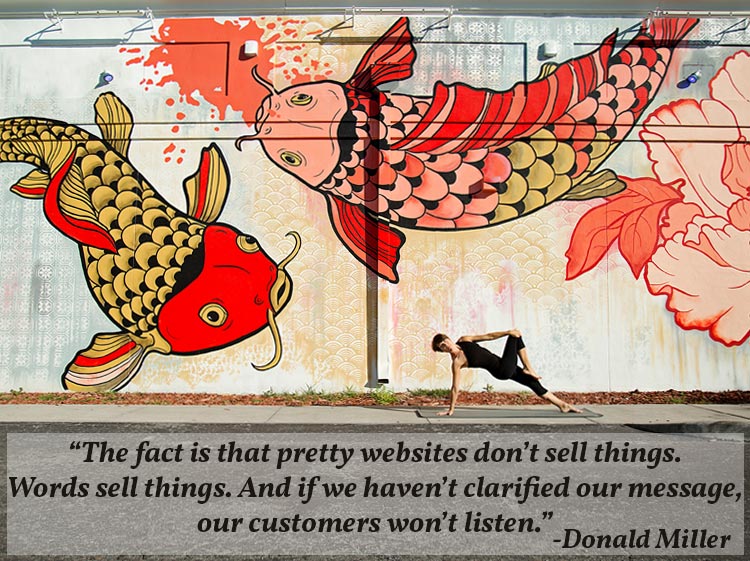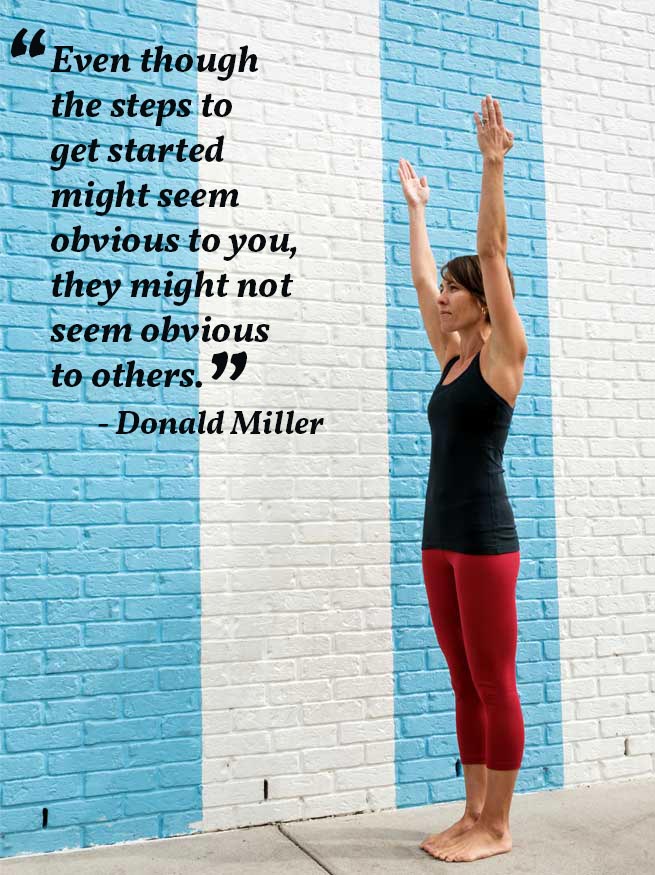 Many yoga instructors fall short in getting more clients due to one big marketing mistake–they did not learn how to craft a clear message about their yoga business. Potential clients get confused about what you offer. Or they can’t see the picture of how their lives will improve by working with you. When this happens, your message falls flat. Instead, you can use the StoryBrand framework to convey how your students will survive and thrive as a result of yoga. And, you’ll have a simple, strong message about your brand that they will remember for months and years to come.
Many yoga instructors fall short in getting more clients due to one big marketing mistake–they did not learn how to craft a clear message about their yoga business. Potential clients get confused about what you offer. Or they can’t see the picture of how their lives will improve by working with you. When this happens, your message falls flat. Instead, you can use the StoryBrand framework to convey how your students will survive and thrive as a result of yoga. And, you’ll have a simple, strong message about your brand that they will remember for months and years to come.
I have experienced firsthand the financial loss that can occur when poor messaging is in play. One studio, in particular, had a stunning design at the physical location and a seemingly cohesive website online. Yet when many of my clients wanted to buy passes for family and friends during the holidays, they called me in deep frustration. I investigated the studio website and, while it was beautiful, it was not user-friendly.
You had to scroll down several times on the home page to even find–and purchase–class packages. And, there was not a clear message about what new students could experience once they decided to take the plunge. Potential clients had to jump through too many hoops to get started there. I lost clients as a result, and this trickled down to less income in the pocketbook of the studio owner, too.
Much of my time is spent working with clients who have the same challenges about how to craft a clear message. Thankfully, you can avoid that pain right now. You can tell a story that warmly, and succinctly, engages more clients. By doing this, you position yourself as the perfect guide that will help them overcome challenges and live the life they desire. Ready to learn the seven steps of the process? Alright, let’s go!
A WRITTEN FORMULA FOR SUCCESS
I first heard about the StoryBrand framework when founder, Donald Miller, was interviewed on one of my favorite marketing podcasts. He quickly explained that the number one reason businesses fail is that its message gets lost in the vast amount of noise in the marketplace today.
 Think about it for a second. Random noise probably irritates you, or it’s so irrelevant you tune it out. On the other hand, you probably like to listen to music. In fact, your ears will even perk up when you hear your favorite song starting on the radio or playing in the background of a coffee shop. That’s because music is comprised of sound waves that follow certain rules, and these rules allow the brain to engage on a different level.
Think about it for a second. Random noise probably irritates you, or it’s so irrelevant you tune it out. On the other hand, you probably like to listen to music. In fact, your ears will even perk up when you hear your favorite song starting on the radio or playing in the background of a coffee shop. That’s because music is comprised of sound waves that follow certain rules, and these rules allow the brain to engage on a different level.
Your Story is Similar to Music
As Don says, “A good story is just like music in that it takes a series of random events and distills them into the essence of what really matters.” The StoryBrand framework shows you how to do just that. You’ll discover how a well-told story can integrate with your brand’s message to engage more customers and grow your business. Just make sure to keep these three basic elements in mind before you move on to Step 1.
1. Keep your message simple
The human brain is the largest consumer of energy in the body, and in order to survive, it wants to be efficient. When a client reads or hears your message, they are burning calories to process that information. If that message is confusing, their survival mechanism kicks in and starts to tune you out. Instead, you need a simple, quick message they can understand.
2. Make sure your message is relevant
There are many things you need to survive–physical health and safety, emotional well-being, strong relationships, and a spiritual connection. If your story doesn’t explain how yoga will directly change a student’s life in one–or many–of these areas, they won’t be interested. The message won’t be relevant to them, and they will stop listening.
3. Create a repeatable message
A repeatable message is both simple and relevant. Clients will remember your brand and be your best advocates via word-of-mouth marketing. Not only does your clientele grow faster this way, but you save money on your advertising budget at the same time!

Photo Credit: Ember and Earth Photography
STEP 1: A CHARACTER
All good stories start with a character. The temptation when telling the story about your yoga business is that you’re the main character. You’re the hero. Yet each person sees themselves as the hero of their own lives. If your story is about you as a hero, potential customers can’t see themselves in your story and won’t want to listen any further.
Instead, you need to position your students as the hero. In order to do this, you need to know the following things:
- Who is your ideal customer?
- What do they aspire to?
- What specific desire can you help them achieve? (People often make the mistake of picking too many)
- How do you tell customers (the main character) where you can take them?
STEP 2: HAS A PROBLEM
Within minutes of reading a book, or watching a movie, you discover that the main character has a problem that is preventing them from getting what they want. This is known as “the hook” in storytelling. There are three main types of problems your character faces:
- An external problem is a physical, tangible problem, like a client who wants to fit in their jeans again or wants to reduce their stress levels.
- An internal problem is the underlying reason behind an external problem. It could be poor health, lack of confidence, lack of skills, confusion, or even frustration.
- A philosophical problem addresses the reasons why a character wants to succeed. It’s the deeper meaning of the story. Yoga is innate with a deeper purpose in life, and if you can craft a clear message that helps your clients solve a philosophical problem, you build a strong bond with them. And, you position yourself as a guide in the narrative of their life.
But before we move on to how you will play the role as a guide, it’s essential to understand that most individuals can’t solve their own problems because they face a villain. This villain is the root source of your client’s frustration. In the yoga world, the villain is not likely a person. Instead, it’s an aspect of life that as personified characteristics. One example of this could be distractions that drain your energy, separate you from quality time with your family, and wreak havoc on your brain.
Ask yourself:
- What is the main source of my client’s frustration?
- Is this villain familiar for many people?
- Do they recognize it when they see it?
- Is this villain real? (No need to project fear here. Just consider what one, real villain could be stopping your clients from living their best life now)

Photo Credit: Rhand McCoy
STEP 3: AND MEETS A GUIDE
Since you are not the hero in the story of your yoga business, you need to play the guide. Like you, your students are on a transformational journey. You just happen to be one–or many–steps ahead of them in the yoga field. Your experience, knowledge, and passion can be a powerful way to lead clients down the path.
In order to demonstrate you’re the right guide for students, empathize with them. Let them know you’re been where they are and you understand their thoughts, feelings, and desires. Then, share your authority in the field. Show that you are a competent leader, and while you might not be perfect, you have serious experience helping others experience transformation. Use these three, powerful sentences to empathize with others:
The best way to show your authority is to have others tell your story. Include three or four testimonials or case studies of transformation on your website. Share the success of others in your newsletter or social media sites. It won’t take long for potential clients to realize that you’re credible. Thus, keep the stories brief.
Other ways to give your clients confidence in you:
- Include stats of how many students you’ve taught
- Add small images of awards you have received on your website
- Place logos of other businesses you’ve worked with in the past.
- This lets clients know you’ve helped others overcome challenges, too.
STEP 4: WHO HAS A PLAN
Imagine that you walk into a yoga class where the instructor says, “Welcome! Thanks for being here today. We’ll use the next hour to just do what you want. Move your body. Enjoy the space. I’ll be here if you need me.” The experience would probably chaotic, and most definitely unprofessional!
You show up prepared, though. You create detailed, specific class outlines when teaching. The same should be the same when you craft a clear message about your yoga business. Outline a path of hope that your clients can take to achieve the results they want.
The best way to explain your plan to potential (and new clients) is through a basic process. This could be three simple steps like:
- Check our schedule
- Find a class that fits your time slot and physical needs
- Step on your mat and nourish yourself today
Or, if you’re building private clients, you might encourage them to:
- Schedule an appointment
- Allow us to create a customized plan for you!
- Let’s work that plan together!
Before you put these steps in place…
Make sure know exactly what you want to offer your students. Only then can you easily help clients reach theirs in simple, clear steps. One final note: you might even want to add a “Satisfaction agreement” or “quality guarantee” on your site to soothe any concerns people have before getting started with you.
STEP 5: CALL THEM TO ACTION
Many people do not take action unless they are actually challenged to do so. As their guide, you get to be the external force that invites them to change. If you do this too softly, the call to action won’t get noticed. But, as a yoga professional, you also don’t want to get grouped with pushy, loud infomercial hosts, either.
 In the StoryBrand Framework, there are two ways you can call your clients to action in authentic and acceptable ways. The first is through transitional calls to action. This is like asking someone out on a date. This request has a low risk and commitment level for clients.
In the StoryBrand Framework, there are two ways you can call your clients to action in authentic and acceptable ways. The first is through transitional calls to action. This is like asking someone out on a date. This request has a low risk and commitment level for clients.
A transitional call to action for your yoga business could be:
- Providing free yoga classes to the community
- Filming free classes, and putting them online, so people get to know your voice and style
- Offering a freebie on your website (which also helps build your email list)
The second call to action is a direct one. This would be an obvious “BUY NOW” button at multiple locations on your website. Other direct phrases include “Schedule an appointment” or “Register today.”
Remember to ask yourself:
- What value could I offer for free to start a relationship with potential clients?
- How often do I repeat my direct calls to action on my website, in my emails, or on social media channels?
- Am I really clear about my offer?
- In what ways am I minimizing risk for my clients?
Photo Credit: Jay Farrell Photography
STEP 6: HELP THEM AVOID FAILURE
To motivate people to take action, it helps paint the picture of how their life will be different as a result of practicing yoga with you. Unfortunately, many people are more likely to take action in order to avoid something unwanted then to go after what they do want.
As their guide, you want to effectively warn your clients about potential pitfalls. Do this by sharing some potential consequences they could face if they don’t spend time on their mat. And to prevent students from getting fearful, only sprinkle in those warnings like you would lightly use salt to season your food.
STEP 7: END WITH SUCCESS
Neurologists claim that the average human spends 30% of their time daydreaming. But if someone is presented with a story, the story does the daydreaming for you. In your yoga business, you can paint the picture of success for your students. You can use pictures to cast a vision for their future. You can describe a positive ending to the story for your clients.
This last step is the most important in the StoryBrand framework because it provides a resolution to the external, internal and philosophical problems your students are facing. They do this with more awareness, wisdom, self-acceptance, and transcendence–both on and off of the mat. This successful ending is where you want to take your students! Remind them of that often!
Ask yourself:
- What successful resolutions do I help my students achieve?
- What will their lives look like if they practice yoga with me?
- In what ways do I continually tell my community how my brand can change their life for the better?

Photo Credit: Benjamin Davies
PUTTING IT TOGETHER
If you’re like me, you’re really passionate about the positive transformations yoga can offer. But unless you’re able to craft a clear message about that for potential students to hear, your yoga business can’t grow. Your marketing efforts will fall flat, and you’ll waste lots of time, energy, and resources trying to build your clientele. Instead, use the seven steps of the StoryBrand framework to create magnetic content and highly engage your community now!
Take Action Now:
- Use these 7 steps to craft a clear message for your yoga business
- Get the StoryBrand Book today for more support in the process.
- Do you hate to write? Are you unsure about the quality of your marketing message? Get a free analysis of your website and marketing material today.








Leave A Comment